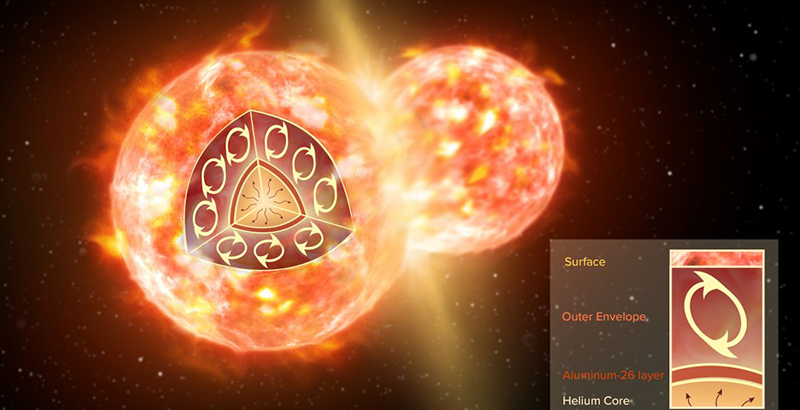In July 2018, researchers reported the first definitive detection of a radioactive molecule outside of the solar system. The molecule, aluminum monofluoride (AlF), contains the radioactive isotope aluminum-26, forged deep inside a star through nuclear fusion. The findings provide insight into the extremely rare event when stars smash into each other—a mechanism necessary for dislodging the aluminum from a star's interior. See also: Aluminum; Element (chemistry); Isotope; Molecule; Nuclear fusion; Periodic table; Radioactivity; Solar system; Star; Universe

Observations from a pair of radio telescopes, the Atacama Large Millimeter/submillimeter Array (ALMA) and the NOrthern Extended Millimeter Array (NOEMA), detected the light signature of the radioactive aluminum in the remains of a stellar collision. This remnant, known as CK Vulpeculae, is located about 2,000 light-years from Earth. It currently looks like a blobby nebula with two lobes of gassy material expanding out from a luminous central region. The event that generated those lobes took place nearly three-and-half-centuries ago, in 1670. That year, human skywatchers recorded a bright, red, apparently "new" star, or nova, that soon became too faint for the naked eye to discern. Modern telescopic observations revealed CK Vulpeculae to be the aftermath of two average, Sunlike stars colliding and scattering debris throughout their local space—a very rare event. See also: Nebula; Nova; Telescope
One of these stars must have been an aged version of our Sun, known as a red giant. Evolutionary models of stellar interiors indicate that a layer of aluminum-26 should form within these stars around a core of helium. The collision of the two stars, ultimately forming CK Vulpeculae, gouged out the material. A researcher involved in a new study reporting the discovery likened this material to the "guts" of a star, ripped out centuries ago and laid bare for astronomers to see. See also: Giant star; Helium; Hertzsprung-Russell diagram
These sorts of stellar disembowelments, however, cannot plausibly account for all three Suns’ worth of mass of aluminum-26 estimated to exist throughout the Milky Way. Researchers have inferred this amount of galactic aluminum-26 through detection of a gamma ray with a specific energy, emitted by the decay of magnesium-26, itself a radioactive decay product of aluminum-26. Other, as-yet-unidentified phenomena must therefore contribute to the Milky Way's stock of transient aluminum-26. See also: Galaxy; Gamma-ray astronomy; Gamma rays; Magnesium; Milky Way Galaxy





